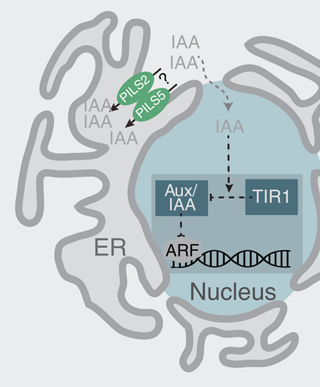On the Interregulation of ER Stress Response and Auxin Signaling
SUPERVISOR: Jürgen KLEINE-VEHN
PROJECT ASSIGNED TO: Jonathan FERREIRA DA SILVA SANTOS
Plants undergo frequent changes in environmental conditions, such as the fluctuations in temperature, light and humidity that happen throughout the day. However, extreme environmental variations induce a stress response, which negatively affects plant development and crop productivity. Such extreme events are likely to become more common with the global climate change, increasing the importance of studying the molecular mechanisms by which plants respond to stress conditions.
The endoplasmic reticulum (ER) is one of the signalling hubs by which plant cells sense and respond to stress. Environmental stress disturbs protein folding in the ER, resulting in the accumulation of incorrectly folded proteins. Plants can cope with ER stress through the degradation of misfolded proteins via the ER-associated degradation (ERAD) and by the activation of the unfolded protein response (UPR). The UPR minimise the ER stress by attenuating protein synthesis and inducing the expression of UPR genes, such as molecular chaperones and ERAD components. Specifically, transmembrane (ERAD-M) and luminal proteins (ERAD-L) can be degraded in an HRD1-dependent manner. In this pathway, the HRD1 complex identifies ERAD-M/L substrates, eliciting their HRD1-dependent retro-translocation, ubiquitination and proteasome-dependent degradation, mitigating the ER stress. Besides the role on the regulation of ER stress, data from yeast and mammal systems suggest that ERAD is also involved in the regulation of the levels of properly folded proteins. Compared with those systems, the mechanisms of the ER stress response are poorly understood in plants, especially when considering the plant-specific mechanisms that may regulate growth under stress conditions. Auxin signalling may be one of such mechanisms since it is responsible for the regulation of many cellular and developmental processes and also integrates environmental cues into developmental programs.
There is growing evidence suggesting that auxin may play a role in the regulation of ER homeostasis. PIN-LIKES (PILS) are putative auxin transport facilitator that, presumably, transport auxin from the cytoplasm to the ER lumen, therefore limiting the available auxin for nuclear signalling (Figure 1). Published data indicate that pils2 and pils5 mutants have reduced UPR activation under ER stress conditions (Chen et al., 2014), while the overexpression of PILS results in constitutive UPR activation (unpublished). Thus, my PhD project aims to investigate the mechanisms by which PILS may balance stress adaptation and growth regulation in plants.

Figure 1: PILS presumably facilitate the transport of auxin from the cytoplasm into the ER lumen, preventing it to diffuse into the nucleus and interfering with auxin signalling.
